Defining Elegant Glass
By Debbie and Randy Coe
Issue No. 415 - March 2008
Several years ago the term, Elegant Glass, was developed by noted glass author, Gene Florence, in order to distinguish
better made glass from the cheaper machine made glass of the Depression time period. Collectors eagerly accepted this
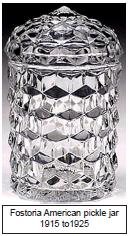 term and now all the higher quality glass is referred to as Elegant Glass. We have found that not everyone was in agreement
to what each term actually meant. We thought if we went with step by step explanations, then
things would be easier to understand. In this article, we will try to help you understand some of
term and now all the higher quality glass is referred to as Elegant Glass. We have found that not everyone was in agreement
to what each term actually meant. We thought if we went with step by step explanations, then
things would be easier to understand. In this article, we will try to help you understand some of
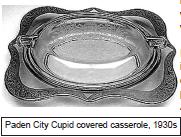 the terms and other special names used among glass enthusiasts.
the terms and other special names used among glass enthusiasts.
Elegant Glass would encompass some glassware produced during the Great Depression, but would not be limited to only those years. The fact that a pattern would be called Elegant Depression Era Glass and yet was produced from 1915 until 1981, like the American pattern, is confusing.
Elegant glass is hand made, either pressed, blown or a combination of the two processes. This type of glass involves many steps to achieve a finished product. The glass is first put in a mould either by pressing or blowing. After removing it from the mould, the piece could have special crimping, flaring or cupping done to it in addition to being etched or gold encrusted. Handles, feet or special ornamentation can also be applied. Unlike Depression glass, Elegant Glass was only sold in fine department stores and never offered as a premium or promotion.
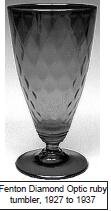 Part of the confusion for collectors comes from the fact that several of the same patterns are
listed in both Elegant and Depression Glass books. We have had collectors ask us why this
situation exists. All we can tell them is what our definition of Elegant Glass is versus other
authors. It is all an opinion of whoever you ask on where they put what a pattern and for what
reason. As we go through the various steps we use to define
what an Elegant pattern is, then you can better understand on
Part of the confusion for collectors comes from the fact that several of the same patterns are
listed in both Elegant and Depression Glass books. We have had collectors ask us why this
situation exists. All we can tell them is what our definition of Elegant Glass is versus other
authors. It is all an opinion of whoever you ask on where they put what a pattern and for what
reason. As we go through the various steps we use to define
what an Elegant pattern is, then you can better understand on
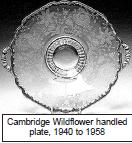 why we put the patterns we did in our Elegant Glass book.
why we put the patterns we did in our Elegant Glass book.
In the case of hand made heat sensitive glass, it is first made into a desired shape, then it is put back into the glory-hole to establish its final color. Machine made glass has a different process to establish the color. Ruby starts out appearing to be Amber and then upon reheating magically changes into a beautiful red color. Another example of this is the opalescent color. The reheating of the piece brings out the fiery opalescence. This hand workmanship is one of the ways that differentiates Elegant, from the mass produced, Depression glass.
For making etched pieces, there were many labor intensive steps following the glass making
process. Skilled workers needed to be trained to ensure every step was properly followed to
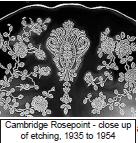
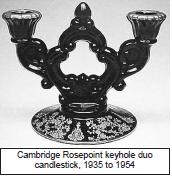 end up with a correctly finished product. Etching is probably the most important treatment that
sets Elegant Glass apart from Depression glass.
Depending on the company, there could be over a dozen steps involved to achieve a final
etched product.
end up with a correctly finished product. Etching is probably the most important treatment that
sets Elegant Glass apart from Depression glass.
Depending on the company, there could be over a dozen steps involved to achieve a final
etched product.
An etching plate is first developed. The artist will come up with a design that is then transferred to a selected flat and smooth steel plate. The design then becomes etched upon the plate itself by a needle cutting technique. This becomes the master etching plate once the design has been approved. The plate is then sent to a printer to make a paper copy that could be used on the glass. The ink used in the paper has a bees wax base. This is important for two reasons. First, the paper needs to stick to the glass and second, it also should resist the action of the added acid. As for the paper, it is of a special type that is extremely soft and pliable. A wax is scraped into the surface of the steel plate, filling every tiny groove. The paper is then applied over this waxy substance and carefully rubbed into the design. The paper is carefully removed, with the wax adhering to it and put very carefully on the desired piece of glass.
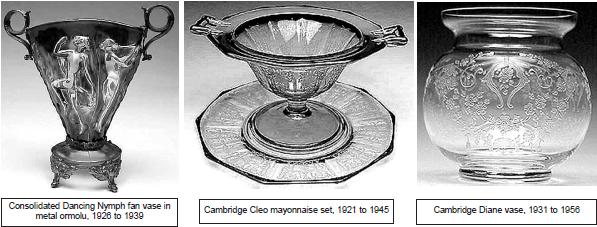 The next step involves
completely rubbing the print onto the glass. Care is given that no wrinkles develop in
the paper that could mar the design on the glass. The piece is then passed on to
another worker that dips the glass into denatured alcohol. The paper is then pealed
away leaving the desired effect on the glass. A wax is then sprayed on the piece to
reveal any defects in the design that can be corrected in the next step. A brush is used
to paint on a hot wax that will seal any of the pinholes that could ruin the design. A last
coating of wax, which rapidly hardens, sits on the piece for several hours before the
piece is put into a hydro-fluoric acid bath. The acid soaks into the exposed places of
the print. Timing is also crucial at this step to ensure the desired look of the pattern.
The glass is first rinsed in cold water and then passes into a hot water bath where all
the wax is melted off. In between all these steps, several inspections are made to
make sure the glass still looks accurate.
The next step involves
completely rubbing the print onto the glass. Care is given that no wrinkles develop in
the paper that could mar the design on the glass. The piece is then passed on to
another worker that dips the glass into denatured alcohol. The paper is then pealed
away leaving the desired effect on the glass. A wax is then sprayed on the piece to
reveal any defects in the design that can be corrected in the next step. A brush is used
to paint on a hot wax that will seal any of the pinholes that could ruin the design. A last
coating of wax, which rapidly hardens, sits on the piece for several hours before the
piece is put into a hydro-fluoric acid bath. The acid soaks into the exposed places of
the print. Timing is also crucial at this step to ensure the desired look of the pattern.
The glass is first rinsed in cold water and then passes into a hot water bath where all
the wax is melted off. In between all these steps, several inspections are made to
make sure the glass still looks accurate.
After the etching process, the piece can then undergo another step. To achieve an
exceptional appearance, the piece could then have gold, silver or platinum applied to
the etching. This step is called Encrusting. To further accentuate the piece, a metal ormolu could be applied. In this case,
usually the glass was purchased by a decorating company. Apollo Metalworks of New York was one of these companies.
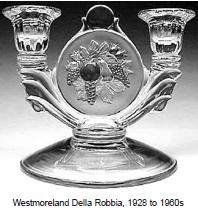
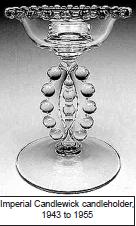 They would buy glass from several different companies and then add their ornate decoration. The piece would then be
marketed under their own label and not the glass company.
They would buy glass from several different companies and then add their ornate decoration. The piece would then be
marketed under their own label and not the glass company.
Another step that could be used to make the piece different was to add different paints or stains to the glass. The piece was then re-fired to seal the stain or paint to the glass. All of these labor intensive further added to the cost of the piece of glass.
One of the final steps in the glass making process was to fire polish. In this step, the glass is reheated to remove any mould seams and to give it extra clarity. The final step is to grind and polish the bottom of the piece to allow it to have a smooth surface. Not every piece in a pattern was ground nor did every company do this. These are more steps used to show the difference between Elegant and Depression.
Elegant Glass was sold in fine department and
jewelry stores. These stores also carried many china
and silver patterns allowing customers to mix and
match the selections with their own preferences. All
these patterns remained open stock items for several
years. Open stock meant, having your particular pattern available
for many years so you could go back to that store to purchase
additional items to add to your set. Many of these patterns were
very extensive and ran for many years, even several decades.
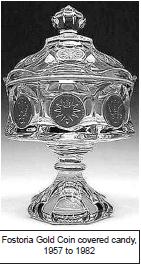
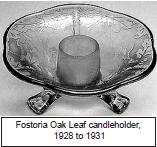 Not every piece was available every year as different items were
periodically added and dropped from the line. Some items were
only available for very short time periods making them hard to
find today and usually expensive.
Not every piece was available every year as different items were
periodically added and dropped from the line. Some items were
only available for very short time periods making them hard to
find today and usually expensive.
Fostoria’s Cupid pattern would have been one of the shortest lived Elegant Glass patterns. It was introduced in 1927 and lasted until 1929. Over the three years, it was produced in the following colors: Amber, Black (called Ebony), Blue, and Green. This was part of a line which Fostoria called Brocade. Others in this same line which also had a short life were Oak Leaf and Oak Wood. Note, that Oak Wood is the same pattern as Oak Leaf with only the added treatment of iridized finish and gold trim setting it apart.
When you look at some of the longest produced Elegant Glass patterns, Fostoria’s American comes to mind. Introduced in 1915 and was last made by Fostoria in 1981. We feel that it is the single most asked for glassware pattern by name that was ever produced. Many times collectors will ask us if we have their Fostoria pattern and usually what they mean is American.
The patterns that were etched were usually found on
several types of blanks. The different styles of blanks,
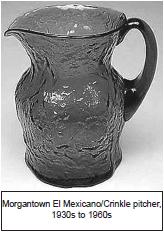 with the same etching, gives the collector a wide range of
choices if only trying to build a specific place setting. For
with the same etching, gives the collector a wide range of
choices if only trying to build a specific place setting. For
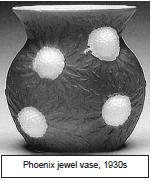 those collectors trying to obtain everything made in a
pattern, they will spend years and a vast amount of money.
The following companies, in our opinion, made Elegant Glassware: Cambridge, Central,
Consolidated, Duncan & Miller, Fenton, Fostoria, Heisey, Imperial, Morgantown, New
Martinsville, Paden City, Phoenix, Tiffin, Viking, and Westmoreland. Gradually, through the
years most of these have closed.
those collectors trying to obtain everything made in a
pattern, they will spend years and a vast amount of money.
The following companies, in our opinion, made Elegant Glassware: Cambridge, Central,
Consolidated, Duncan & Miller, Fenton, Fostoria, Heisey, Imperial, Morgantown, New
Martinsville, Paden City, Phoenix, Tiffin, Viking, and Westmoreland. Gradually, through the
years most of these have closed.
The first to close was Central Glass Works in 1939. In the 1940s, New Martinsville closed, reorganized and was then given the new name of Viking so it could have a fresh start. After the end of World War II many cheaper imports were flooding into the United States and many American companies could not compete with these products. As a result of this during the 1950s, Cambridge, Duncan & Miller, Heisey, and Paden City glass companies all closed. This was a tremendous loss in the number of American companies making elegant glass.
Tiffin (U.S. Glass) closed in the early 1960s before being bought by employees. A few years later it was sold to Continental Can. In 1968, the company was sold to Interpace, who also owned Franciscan China. In 1979, Tiffin was sold again, this time to Towle Silversmiths before the division was finally shut down in 1980. Consolidated closed in 1964. Fostoria purchased Morgantown in 1965 but allowed them to operate under their own name. The Morgantown plant was sold in 1972 to Bailey Glass with the Morgantown name disappearing. In 1970 Phoenix was purchased by Anchor Hocking.
In the 1980s, several more companies closed: Fostoria, Imperial, Viking, and Westmoreland. Viking was purchased several years later by Kenneth Dalzell, who reopened it under the Dalzell-Viking name. Kenneth Dalzell was a former Fostoria employee. In 1998, the company was forced to close due to several problems. Lancaster Colony, who also owned Indiana Glass, purchased Fostoria. For awhile they continued to utilize some of the moulds, but soon eliminated most of the high quality finish work on their glass that had been previously done at Fostoria. Finally in 2003, after several years of languishing in a warehouse at Indiana Glass, a subsidiary of Lancaster Colony, a decision was made to sell all the cast iron moulds that required extra hand work. The company had finally come to the conclusion that it was no longer economically feasible for them to be producing this type of glass anymore. The focus would now turn to only making their more profitable machine made glass.
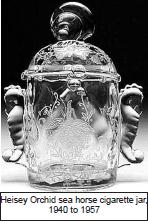
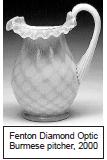 Fenton became the recipient of this major
decision. Several thousand moulds were purchased and are now in the safe hands of
Fenton. Even if Fenton never uses some of these moulds,
no foreign importer will ever be able to unscrupulously
reproduce these items. The moulds had previously been
owned by Cambridge, Fostoria, Imperial and Indiana. In
the case of the former Fostoria Baroque candy box, before it entered the Fenton catalog,
the inner dividers were removed. It was made in a non Fostoria color and the piece now
has the Fenton logo on it. In addition when Fenton put it in their catalog, it was only given
a number and not a name. The reasoning behind this was to emphasize the piece today
and not where the mould came from.
Fenton became the recipient of this major
decision. Several thousand moulds were purchased and are now in the safe hands of
Fenton. Even if Fenton never uses some of these moulds,
no foreign importer will ever be able to unscrupulously
reproduce these items. The moulds had previously been
owned by Cambridge, Fostoria, Imperial and Indiana. In
the case of the former Fostoria Baroque candy box, before it entered the Fenton catalog,
the inner dividers were removed. It was made in a non Fostoria color and the piece now
has the Fenton logo on it. In addition when Fenton put it in their catalog, it was only given
a number and not a name. The reasoning behind this was to emphasize the piece today
and not where the mould came from.
The only company left standing today of this original elegant glass group and continuing to make elegant glass today is the Fenton Art Glass Company. They have survived by continuing to adapt their products to meet the needs of today’s consumers. They are still family owned and now have fourth generation family members working within the company to make decisions for the future of the company and surrounding community. Their acquisition of the many different company moulds will give them the ability to produce some different types of glass without the expense of making an entirely new mould.
In conclusion, we would like to remind you that Depression Era refers only to a time period. Depression
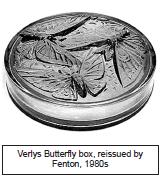 Glass was an inexpensive glass that was mass produced for a short period, sold in the five and dime
stores plus used for premium or promotional purposes. Elegant Glass was a hand made glassware
produced for a long time as open stock merchandise with many different treatments. This type of
glass was sold in Department and Jewelry stores.
Glass was an inexpensive glass that was mass produced for a short period, sold in the five and dime
stores plus used for premium or promotional purposes. Elegant Glass was a hand made glassware
produced for a long time as open stock merchandise with many different treatments. This type of
glass was sold in Department and Jewelry stores.
About the Authors: NCC members Debbie and Randy Coe have published over a half dozen books on Elegant Glass. They have been antique dealers since 1980 and reside in Oregon. They have two daughters who are also published authors. The Coes recently published the 3rd Edition of their book Elegant Glass: Early, Depression, and Beyond.
